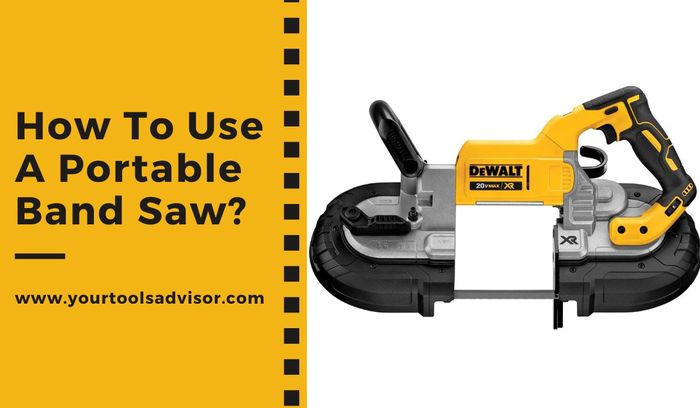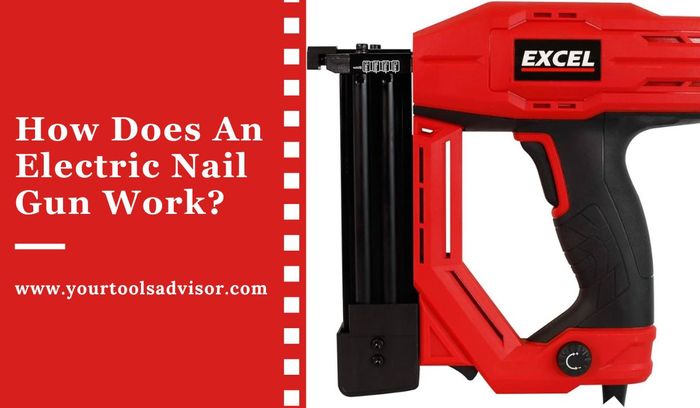When it comes to precision cutting in woodworking, metalworking, or any project that demands accuracy and efficiency, a portable band saw is an indispensable tool.
Its versatility and ability to navigate tight spaces make it a favorite among professionals and DIY enthusiasts alike. However, harnessing the full potential of this powerhouse tool requires a solid understanding of its features and proper techniques.
A portable band saw is a versatile tool that offers flexibility and convenience for various cutting tasks. It consists of a long, continuous blade that is stretched between two wheels.
The portable nature of the band saw allows users to bring it to the workpiece rather than vice versa. This makes it ideal for cutting materials such as metal, wood, or plastic in cramped spaces or on construction sites where power outlets may be limited.
In this comprehensive guide, we’ll walk you through the essential steps on how to use a portable band saw effectively.
Whether you’re a seasoned craftsman looking to refine your skills or a newcomer eager to unlock the potential of this versatile tool, this tutorial will equip you with the knowledge and confidence needed to make precise cuts with ease.
Let’s dive right in…
Different Types Of Portable Band Saws
When looking for a portable band saw, it’s crucial to have a good understanding of the different types available.
Here, we’ll explore two common types: corded and cordless.
Corded Band Saws
Corded band saws are known for their consistent power supply and uninterrupted operation. They are typically more powerful than cordless models and offer a higher cutting capacity. Corded band saws are ideal for heavy-duty tasks and extended use.
However, they may have limitations when it comes to portability due to the need for a power outlet and the power cord.
Cordless Band Saws
Cordless band saws, on the other hand, offer the advantage of unmatched portability and freedom of movement. They run on rechargeable batteries, allowing you to use them in any location without the need for a power source.
While cordless band saws may have slightly lower power compared to their corded counterparts, they make up for it with convenience and ease of use. These band saws are perfect for on-the-go projects or working in tight spaces where access to a power outlet is limited.
So which one is right for you?
Determining whether a corded or cordless band saw is the right choice for you ultimately depends on your specific needs and preferences. If you prioritize portability and convenience, a cordless band saw may be the perfect fit.
However, if you require more power and cutting capacity, a corded band saw might be the better option. Consider the nature of your woodworking projects and the environment in which you’ll be working, then choose accordingly.
Remember, selecting the right portable band saw is crucial for achieving optimal results and maximizing your woodworking capabilities.
How To Use A Portable Band Saw?
A portable band saw is a versatile and powerful tool used for cutting various materials such as wood, metal, and plastics. It consists of a continuous looped blade that moves around two wheels, allowing for precise and efficient cutting.
Whether you’re a professional tradesperson or a DIY enthusiast, understanding how to use a portable band saw safely and effectively is essential.
Follow these seven steps to ensure you get the most out of your portable band saw…
Step 1: Safety Precautions
Before you begin, ensure you have the necessary safety equipment on hand. This includes safety goggles, ear protection, a dust mask, and appropriate clothing to protect against debris. Additionally, make sure the work area is well-lit and free of clutter to prevent accidents.
Step 2: Blade Selection
Choose the appropriate blade for your intended material and cutting application. For example, use a fine-toothed blade for cutting metal and a coarse-toothed blade for wood. Ensure the blade is properly tensioned and securely fastened on the wheels.
Step 3: Adjusting the Cutting Depth
Adjust the cutting depth of the blade to match the thickness of the material you are cutting. This can typically be done by loosening the blade tension and adjusting the height of the guide post or adjusting the depth stop if your band saw has one.
Step 4: Positioning and Securing the Material
Place the material you intend to cut on a stable surface, ensuring it is securely clamped or held in place to prevent any movement during cutting. This is crucial for accurate and safe cutting.
Step 5: Starting the Band Saw
Turn on the band saw and allow the blade to reach its full speed before making contact with the material. Always start the saw with the blade clear of the material to avoid kickback.
Step 6: Making the Cut
With a steady hand, slowly guide the material into the blade. Let the saw do the work and avoid forcing the material through. Keep a firm grip on the material and maintain a steady feed rate.
Step 7: Finishing the Cut
Once the cut is complete, switch off the band saw and wait for the blade to come to a complete stop before removing the material. Ensure the blade has fully stopped rotating before making any adjustments or changes.
Using a portable band saw can be a highly effective way to make precise cuts in a variety of materials.
By following these seven steps and prioritizing safety, you’ll be able to use this versatile tool with confidence and efficiency.
Always remember to wear the appropriate safety gear and consult the manufacturer’s instructions for any specific guidelines related to your band saw model.
Basic Tips For Using A Portable Band Saw
If you’re new to using a portable band saw, mastering the basic techniques is crucial for achieving accurate and clean cuts.
In this section, we’ll cover the key steps for holding the saw correctly, aligning the blade, making straight cuts, and navigating curves and irregular shapes.
Holding The Saw Correctly
Before you begin any cutting task with a portable band saw, it’s important to ensure that you are holding the saw correctly. Holding the saw with a firm grip and maintaining proper balance will not only ensure your safety but also allow for better control and precision.
Here are a few essential tips…
- Hold the handle with your dominant hand and firmly grip the front handle with your other hand for added stability.
- Stand with your feet shoulder-width apart, maintaining a balanced stance throughout the cut.
- Keep your body positioned to the side of the saw blade, away from the cutting line, to avoid any potential kickback.
Aligning The Blade For Accurate Cuts
Proper alignment of the blade is crucial for achieving precise cuts with a portable band saw.
Here’s how to ensure the blade is aligned correctly…
- Start by checking the tension of the blade. A properly tensioned blade will provide optimal cutting performance.
- Next, adjust the tracking on the saw to center the blade on the wheels.
- Inspect the blade guides and bearings to ensure they are properly aligned and adjusted.
Making Straight Cuts
Creating straight cuts with a band saw requires careful attention to the following steps:
- Mark the desired cutting line on the workpiece using a pencil or a marking gauge.
- Position the workpiece firmly on the cutting surface, ensuring it is stable and secure.
- Start the saw, allow the blade to reach full speed, and then slowly guide the workpiece into the blade, following the marked cutting line.
- Maintain a steady pace and ensure consistent pressure to achieve a clean and straight cut.
Navigating Curves And Irregular Shapes
While a portable band saw is excellent for making straight cuts, it can also be effectively used for cutting curves and irregular shapes.
Here are a few tips to keep in mind…
- For tight curves, consider using a narrower blade with a higher tooth count to allow for better maneuverability.
- To cut irregular shapes, start by making relief cuts at strategic points along the shape to prevent binding and ensure smoother cutting.
- Take your time and steer the saw carefully, following the desired curve or shape as closely as possible.
Now that you have a good grasp of the basic techniques for using a portable band saw, you can confidently tackle a wide range of cutting tasks with precision and ease.
Advanced Tips For Using A Portable Band Saw
When it comes to using a portable band saw, mastering some advanced techniques can help you achieve precise cuts and make the most out of this versatile tool.
In this section, we will explore various tips and tricks for getting the best results with your portable band saw.
Whether you’re embarking on resawing and ripping lumber, making bevel cuts, cutting metal, or troubleshooting common issues, these insights are sure to enhance your woodworking or metalworking experience.
Resawing And Ripping Lumber
To make the most out of your portable band saw’s potential for resawing and ripping lumber, follow these tips:
- Use a sharp and appropriate TPI (teeth per inch) blade for the task at hand. A higher TPI blade is better suited for smoother cuts, while a lower TPI blade excels at cutting through thicker materials.
- Ensure the material is securely clamped or held in a stable position to avoid accidents or unwanted movement during the cut.
- Make sure the blade tension is properly adjusted. An overly tight or loose blade tension can affect the accuracy of your cuts.
- Take your time and maintain a steady pace when feeding the material through the blade. Avoid pushing too hard or forcing the cut, as it may result in a jagged or rough finish.
- Consider using a fence or guide to help maintain a straight and consistent cutting line.
- Stay aware of your body positioning and maintain a firm grip on the saw. Always follow safety guidelines and wear protective gear.
Making Bevel Cuts
If you need to make bevel cuts with your portable band saw, the following tips can help you achieve precise and accurate results:
- Adjust the table angle to the desired bevel angle before starting the cut. Ensure that the table is securely locked in place.
- Consider using a miter gauge or a bevel guide to help you maintain a consistent angle throughout the cut.
- Begin the cut slowly and steadily. Be mindful of the blade’s position and alignment to prevent any unintended deviations.
- Take your time and maintain a steady feed rate, allowing the blade to do the work. Avoid rushing or applying excessive pressure, as it may compromise the quality of the cut.
- After completing the cut, inspect the bevel angle to ensure it matches your desired specifications. Make adjustments as necessary.
Cutting Metal With A Portable Band Saw
When it comes to cutting metal with a portable band saw, keep the following tips in mind:
- Choose the appropriate blade for cutting metal. Bi-metal blades are specifically designed for metal cutting and offer superior performance and durability.
- Apply cutting fluid or lubricant to the material to reduce friction and heat generation, enhancing the cutting process and prolonging blade life.
- Securely clamp the metal piece or use a vise to ensure stability during the cut. This will prevent vibrations and potential accidents.
- Take it slow and allow the blade to gradually penetrate the metal. Excessive force or high feed rates can cause the blade to bind or break.
- Regularly check the blade for signs of dullness or wear. Replace the blade when necessary to maintain optimal cutting performance.
Troubleshooting Common Issues
Even with proper usage, portable band saws can encounter common issues.
Here are some troubleshooting tips to consider:
- If the cut is not straight or drifts off course, check the blade tension and alignment. Adjust as needed and make sure the guides are properly set.
- If the blade tends to overheat or produces excessive sparks, ensure that you are using the correct blade for the material being cut. Also, using a cutting fluid or lubricant can help reduce heat buildup.
- In case of blade breakage, examine the blade for any signs of damage, such as dullness, cracks, or missing teeth. Replace the blade with a new one as necessary.
- If you encounter unexpected vibrations or excessive noise, verify that the saw is securely assembled, and all components are tight and aligned correctly.
By following these advanced techniques and tips, you can unlock the full potential of your portable band saw and achieve superb cutting results.
Remember to prioritize safety throughout your woodworking or metalworking projects and always refer to the manufacturer’s guidelines.
FAQs On How To Use A Portable Band Saw
What Would You Use A Portable Band Saw For?
A portable band saw is used for cutting various materials like wood, metal, or plastic. It offers convenience and versatility for both professional and DIY projects. It allows for precise and efficient cutting in tight spaces, making it ideal for construction, plumbing, metalworking, and more.
How do you cut with a portable bandsaw?
To cut with a portable bandsaw, first, secure the material you’re cutting in a stable position. Adjust the blade speed and feed rate according to the material’s thickness. Slowly guide the saw along the desired cutting line, applying steady, even pressure.
Can You Cut Wood With Portable Band Saw?
Yes, a portable band saw can cut wood. It is a versatile tool that can make accurate and precise cuts in various materials, including wood. Its portability makes it convenient for woodworking projects.
Is a portable bandsaw worth it?
Yes, a portable bandsaw can be worth it for tasks like cutting metal or wood in tight spaces or on job sites without access to a stationary bandsaw. Its versatility and portability make it a valuable tool for many professionals and DIY enthusiasts.
How to use a band saw?
To use a band saw, first, make sure it’s properly set up and adjusted for the material you’re cutting. Secure the workpiece firmly in place, keeping your fingers clear of the blade’s path. Turn on the saw, feed the material steadily into the blade, and maintain a controlled, even pace while cutting.
Always prioritize safety by wearing appropriate protective gear and following manufacturer’s guidelines.
How does a horizontal band saw work?
A horizontal band saw works by using a continuous looped blade with teeth to cut through materials. The material is secured on a flat surface, and the blade moves in a horizontal motion, slicing through the material as it passes through.
How does a band saw work?
A bandsaw works by using a continuous looped blade with teeth to cut material. The blade is stretched over two wheels, one of which is powered, creating a continuous motion that allows for precise and versatile cutting of various materials.
Conclusion
To wrap things up, mastering the use of a portable band saw can be a game-changer for any craftsman or DIY enthusiast.
By following the proper safety precautions, understanding the various operations, and optimizing the tool’s settings, you can effortlessly tackle a wide range of cutting tasks.
Remember to regularly maintain your portable band saw to ensure its longevity and effectiveness. With practice, patience, and a little bit of creativity, the portable band saw can become your go-to tool for precision cutting and woodworking projects.
Happy cutting!





Leave a Reply